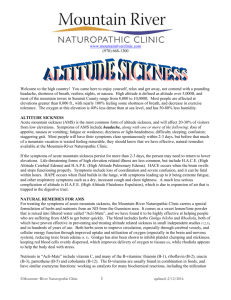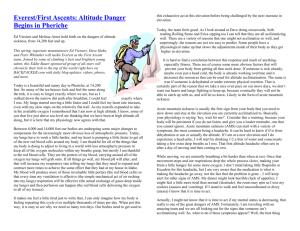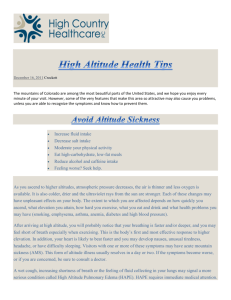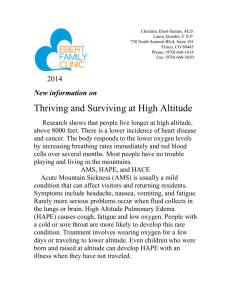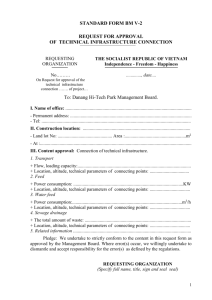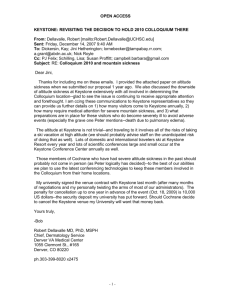File - Huff Hills Ski Patrol
advertisement
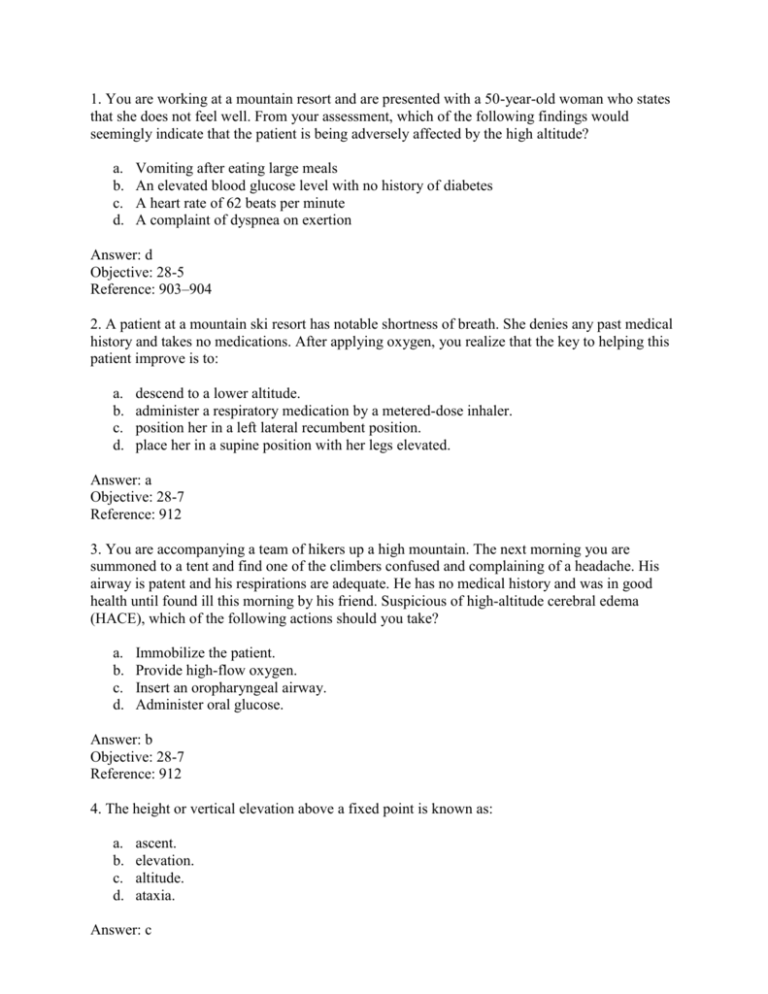
1. You are working at a mountain resort and are presented with a 50-year-old woman who states that she does not feel well. From your assessment, which of the following findings would seemingly indicate that the patient is being adversely affected by the high altitude? a. b. c. d. Vomiting after eating large meals An elevated blood glucose level with no history of diabetes A heart rate of 62 beats per minute A complaint of dyspnea on exertion Answer: d Objective: 28-5 Reference: 903–904 2. A patient at a mountain ski resort has notable shortness of breath. She denies any past medical history and takes no medications. After applying oxygen, you realize that the key to helping this patient improve is to: a. b. c. d. descend to a lower altitude. administer a respiratory medication by a metered-dose inhaler. position her in a left lateral recumbent position. place her in a supine position with her legs elevated. Answer: a Objective: 28-7 Reference: 912 3. You are accompanying a team of hikers up a high mountain. The next morning you are summoned to a tent and find one of the climbers confused and complaining of a headache. His airway is patent and his respirations are adequate. He has no medical history and was in good health until found ill this morning by his friend. Suspicious of high-altitude cerebral edema (HACE), which of the following actions should you take? a. b. c. d. Immobilize the patient. Provide high-flow oxygen. Insert an oropharyngeal airway. Administer oral glucose. Answer: b Objective: 28-7 Reference: 912 4. The height or vertical elevation above a fixed point is known as: a. b. c. d. ascent. elevation. altitude. ataxia. Answer: c Objective: 28-1 Reference: 898 5. As altitude increases: a. b. c. d. barometric pressure increases. the partial pressure of oxygen decreases. the concentration of oxygen decreases. air density becomes greater. Answer: b Objective: 28-2 Reference: 900 6. The concentration of oxygen at sea level is approximately: a. b. c. d. 35 percent. 43 percent. 40 percent. 21 percent. Answer: d Objective: 28-2 Reference: 900 7. Your family is planning a ski trip to a resort that is at about 10,000 feet of elevation. You suggest that you spend the first two nights of the trip at a hotel where the elevation is about 6,500 feet. When your children protest that they are in good shape and want to go immediately to the resort, you explain that you are concerned about altitude sickness and that: a. “physical fitness does not necessarily prevent altitude sickness.” b. “just because you children are fit and don’t need the gradual change doesn’t mean your mom and I don’t need it.” c. “your mom and I will exercise more before the trip so that maybe we can reduce the delay to one night.” d. “I’ll see if I can get some medication so that we don’t need to stop over at the lower elevation.” Answer: a Objective: 28-4 Reference: 903 8. You are teaching a class on acute mountain sickness. When one of your students asks you to explain the term acclimatization in relation to AMS, your best response would be which of the following statements? a. “Physiologic changes that increase the body’s ability to adjust to extreme changes in temperature.” b. “Physiologic changes that decrease the body’s need for oxygen at high altitudes.” c. “Physiologic changes that decrease the body’s need for slow ascents.” d. “Physiologic adjustments that increase the delivery of oxygen to cells.” Answer: d Objective: 28-4 Reference: 902 9. Which of the following processes does not occur during acclimatization? a. b. c. d. An increase in respiratory rate and depth Dilation of pulmonary blood vessels An increase in red blood cell production An increase in heart rate Answer: b Objective: 28-2 Reference: 902 10. In an otherwise healthy individual, the presence of a headache and feelings of sickness at high altitude is known as: a. b. c. d. a high-altitude migraine. acute mountain encephalitis. acute mountain sickness. high-altitude pulmonary edema. Answer: c Objective: 28-5 Reference: 903 11. The most common cause of death related to high altitude is: a. b. c. d. HAPE. chilblains. AMS. HACE. Answer: a Objective: Supplemental Reference: 904 12. You are with a group of hikers on the third day of an 11,000-foot mountain ascent. One of the hikers has not been feeling well for a couple of days. Today, members of the group notice that he is having difficulty getting dressed and speaking. From your training in outdoor emergency care, you recognize that these signs and symptoms are most often associated with: a. acute mountain sickness. b. peripheral neuropathy. c. frostbite. d. HACE. Answer: d Objective: 28-5 Reference: 905 13. You are teaching a class to OEC candidates and explain that a pre-existing illness may be complicated by the effects of high altitude. In teaching this concept to your class, you explain that the reason for this effect is that: a. b. c. d. the increased barometric pressure at high altitude makes the heart work harder. less oxygen is available to vital organs at high altitude. dehydration can limit circulating blood volume. nausea makes it difficult for people to take their medications. Answer: b Objective: Supplemental Reference: 906 14. High-altitude pulmonary edema most commonly affects: a. b. c. d. young healthy individuals. individuals with a history of COPD. middle-aged, out-of-shape hikers. individuals who ascend higher than 7,500 feet. Answer: a Objective: Supplemental Reference: 904 15. Labored breathing at rest and audible chest congestion herald the development of a serious, potentially life-threatening stage of what altitude-related condition? a. b. c. d. Acute mountain sickness Peripheral edema HAPE Khumbu cough Answer: c Objective: 28-5 Reference: 904–905 16. The most effective method for preventing high-altitude illness is to: a. b. c. d. make gradual ascents. maintain adequate hydration and eat a high-carbohydrate diet. take medications such as Diamox. avoid drinking alcohol. Answer: a Objective: 28-4 Reference: 909 17. You are working at the summit of a 9,000-foot mountain. A 60-year-old woman is brought to you complaining of headache, fatigue, and shortness of breath. You prepare to do your assessment and recognize that your goal is to: a. give her some ibuprofen to ease her headache. b. determine whether this is an emergent condition so that you can initiate life-saving treatment. c. get the patient lying down to relieve her presenting symptoms. d. find out if she has an inhaler she can use to relieve her shortness of breath. Answer: b Objective: 28-6 Reference: 911 18. Given that 50 percent of patients with HAPE also have symptoms of AMS, it is important that you ask patients if they have had which of the following groups of signs/symptoms? a. b. c. d. Headache, blurred vision, peripheral edema Harsh cough, itchy skin, nausea Difficulty sleeping, vomiting, ataxia Fatigue, nausea, difficulty sleeping Answer: d Objective: 28-6 Reference: 911 19. What percentage of patients who have HAPE do not develop AMS first? a. b. c. d. 10 percent 20 percent 40 percent 50 percent Answer: d Objective: 28-6 Reference: 904 20. In order to assess for a key symptom of HACE, you would ask patients to: a. b. c. d. walk a straight line heel to toe. take a deep breath and let you know if it hurts. tell you if their rings are fitting tightly. read an eye chart. Answer: a Objective: 28-6 Reference: 912 21. You have a 32-year-old male patient who just arrived at the aid room on the top of a 9,000foot peak. You think he may be exhibiting signs of altitude sickness. You recognize that the key to a successful outcome of treatment is to: a. b. c. d. get him to lie down so his symptoms do not worsen. start him on oxygen via a nasal cannula. prevent further body cooling by covering him with blankets. recognize the patient’s signs and descend to a lower elevation. Answer: d Objective: 28-7 Reference: 912 22. Your group of climbers has reached an elevation of 8,500 feet. One of the climbers is increasingly short of breath and now has audible chest congestion. Your party has a limited supply of oxygen, which you immediately apply to the climber at 15 LPM via a nonrebreather mask. Based on your assessment that the climber has HAPE, you recognize that the next necessary treatment is: a. b. c. d. a rapid descent of at least 1,500 to 3,000 feet. to administer diuretics such as Diamox to reduce the patient’s pulmonary edema. to get the patient to a physician who can administer dexamethesone. to place the patient in the shock position. Answer: a Objective: 28-7 Reference: 913 23. In order to enjoy their upcoming skiing trip, your family has gathered information about risk factors for high-altitude illnesses. Contributing factors that could make altitude illness worse include: a. b. c. d. a history of angina. a diet that is high in carbohydrates. the lack of regular exercise. COPD. Answer: b Objective: 28-3 Reference: 909 24. You are asked to speak to a college group that is planning a ski trip to the Alps. In order to help them plan for reducing their risks for developing altitude-related illnesses, you suggest all of the following except: a. plan a layover day at between 6,000 feet and 8,000 feet. b. drink 3–4 quarts of fluid a day. c. do a lot of heavy physical exertion early in the trip to help them acclimate. d. sleep at an elevation that is lower than where they will be skiing. Answer: c Objective: 28-4 Reference: 909
